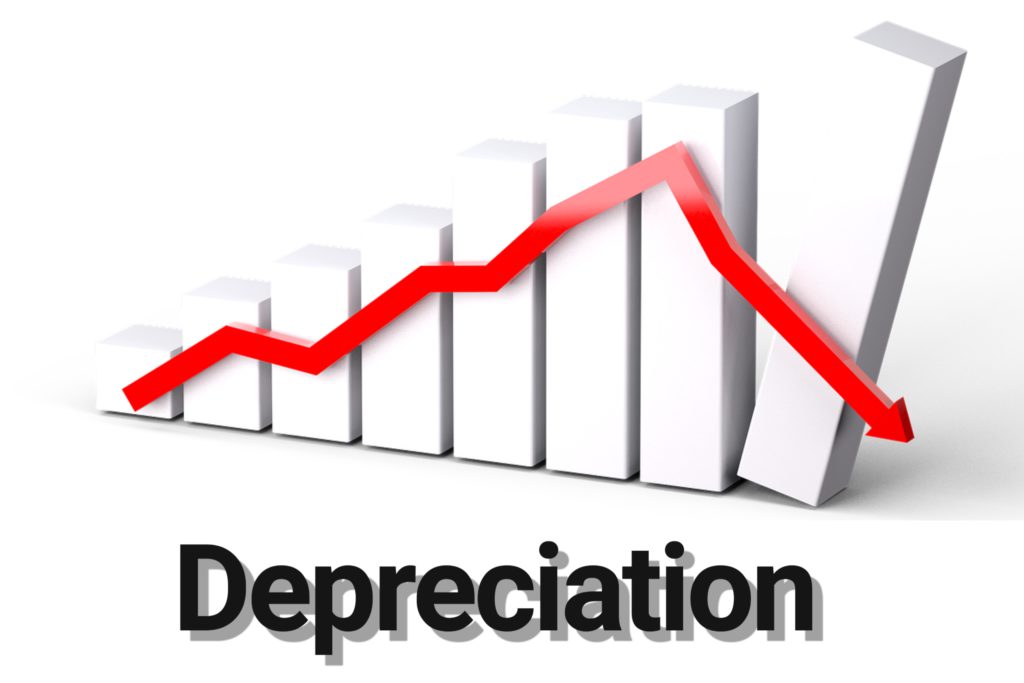
Key Takeaways:
- Depreciation is an accounting method used to allocate the cost of a tangible asset over its useful life.
- It is used to spread out the cost of an asset over time rather than expensing the entire cost in the year of purchase.
- It is important to note that depreciation only applies to tangible assets, not intangible assets like patents or trademarks.
Depreciation is an essential concept in accounting that allows companies to allocate the cost of tangible assets over their useful lives. Rather than expensing the entire cost of an asset in the year of purchase, depreciation spreads that cost out over several years.
This article will delve deep into depreciation to understand why it is crucial for businesses as it plays a significant role in financial statements and business decisions.
What is Depreciation?
Depreciation is a term used in finance and accounting to describe the gradual decrease in the value of an asset over time. Assets, such as buildings, machinery, vehicles, and equipment, are expected to lose value over their useful life due to various factors, including wear and tear from use, obsolescence from technological advancements, or changes in market demand.
It is a way to allocate the cost of an asset over its estimated useful life, reflecting the decrease in value on a company’s financial statements.
It is typically recorded as an expense in the income statement, which reduces the reported net income. The accumulated depreciation is reflected as a contra-asset account on the balance sheet, reducing the asset’s carrying value.
For example:
Suppose you purchase a delivery truck for $50,000, and you estimate that it will have a useful life of 5 years. You also estimate that the truck will have a salvage value of $5,000 at the end of its useful life. Using the straight-line depreciation method, you can calculate the annual depreciation expense as follows:
Annual Depreciation Expense = (Cost of Truck – Salvage Value) / Useful Life Annual Depreciation Expense = ($50,000 – $5,000) / 5 Annual Depreciation Expense = $9,000
This means that each year, you can record $9,000 as a depreciation expense for the truck. Over the course of 5 years, the total depreciation expense for the truck would be $45,000 ($9,000 x 5).
As the truck gets older and accumulates more miles, it will become less valuable and require more maintenance. By recording a depreciation expense each year, you are reflecting the decrease in value of the truck over its useful life.
This allows you to spread out the cost of the truck over the period of time that it is generating revenue for your business, which can help you to more accurately track your expenses and make informed decisions about future equipment purchases.
Importance of Depreciation
Depreciation is a crucial concept in finance and accounting for several reasons:
- Accurate asset valuation: Depreciation allows companies to reflect the true value of their assets on their financial statements. Assets, such as buildings, machinery, and vehicles, lose value over time due to wear and tear, obsolescence, or other factors. By allocating the cost of an asset over its estimated useful life through depreciation, companies can accurately reflect the reduced value of the asset on their financial statements, providing a more realistic picture of the company’s financial position.
- Proper expense recognition: Depreciation is recorded as an expense on the income statement, which helps companies spread the cost of an asset over its useful life. This allows for a more accurate matching of expenses with revenues in the same accounting period, which is a fundamental principle of accrual accounting. Proper expense recognition through depreciation helps companies calculate their net income more accurately, providing a better understanding of their profitability.
- Tax implications: Depreciation also has tax implications. In many tax jurisdictions, depreciation is tax-deductible, which reduces a company’s taxable income and lowers its tax liability. This can result in significant tax savings for companies, helping to manage their cash flow and reduce their overall tax burden.
- Capital budgeting and decision-making: Depreciation is crucial in capital budgeting and investment decision-making. When evaluating investment opportunities, companies need to consider the estimated depreciation expense of the assets involved, as it impacts the future cash flows and profitability of the investment. Accurate depreciation calculations are essential for evaluating the financial feasibility of investment projects and making informed business decisions.
- Financial analysis and valuation: Depreciation is critical in companies’ financial analysis and valuation. Financial analysts and investors use depreciation data to assess a company’s asset quality, evaluate its historical performance, and estimate its future earnings potential. Accurate depreciation calculations are essential for conducting financial ratio analysis, assessing profitability, and determining the value of a company’s assets.
Methods of Depreciation
Companies can use several depreciation methods to allocate the cost of an asset over its useful life. The three common methods of depreciation are:
- Straight-line depreciation: This is the simplest and most commonly used depreciation method. Under straight-line depreciation, the same amount is deducted from the asset’s value each year over its estimated useful life. The formula for straight-line depreciation is:
Depreciation Expense = (Cost of the Asset – Salvage Value) / Useful Life
Where:
Cost of the Asset: The initial cost of the asset.
Salvage Value: The asset’s estimated residual value at the end of its useful life.
Useful Life: The estimated years the asset will be in use.
Straight line results in a constant depreciation expense each year, making it easy to calculate and understand. It is often used when the asset’s usefulness is expected to decline evenly over its estimated useful life, and there are no significant changes in its value or usage pattern.
2. Declining balance depreciation: This method allocates a higher amount of depreciation in the early years of an asset’s life and decreases the depreciation expense over time.
The declining balance method has different variations, such as double-declining balance (DDB) and 150% declining balance (150% DB). The formula for declining balance depreciation is:
Depreciation Expense = (Book Value at the beginning of the year Depreciation Rate)
Where:
Book Value at the Beginning of the Year: The asset’s initial cost minus accumulated depreciation up to the beginning of the year.
Depreciation Rate: A predetermined percentage that represents the rate of depreciation.
The declining balance method results in higher depreciation expenses in the early years and lower expenses in the later years, reflecting the assumption that assets tend to lose value more rapidly in the early years of their useful life. This method is often used for assets expected to have a higher rate of obsolescence or wear and tear in the early years.
3. Sum-of-the-years’-digits (SYD) depreciation: This method allocates more depreciation in the early years and gradually decreases the depreciation expense over time. The formula for sum-of-the-years’-digits depreciation is:
Depreciation Expense = (Remaining Useful Life / Sum of the Years’ Digits) (Cost of the Asset – Salvage Value)
Where:
Remaining Useful Life: The number of years left in the asset’s estimated useful life
Sum of the Years’ Digits: The sum of the digits representing the number of years of the asset’s estimated useful life (e.g., for a 5-year useful life, the sum of the years’ digits would be 1+2+3+4+5=15)
The SYD method results in higher depreciation expenses in the early years and lower expenses in the later years, similar to the declining balance method. This method is often used when the asset’s usefulness is expected to decline more rapidly in the early years but at a slower rate than the declining balance method.
4. Units-of-production depreciation: This method allocates a higher depreciation expense when the asset is used more and allocates less when the asset is used less. It calculates the depreciation expense based on the number of units produced or the hours of usage. The formula for units-of-production depreciation is:
Annual Depreciation Expense = [(Cost of Asset – Salvage Value) / Total Expected Units] x Actual Units Produced
Response (4)
Leave a comment Cancel reply

Options in Finance: A Comprehensive Glossary to Empower Your Understanding

When the world order responds to cryptocurrency: CBDC

India’s CBDC Project: A New Direction Towards Digital Currency

How to Earn Passive Income Using a Staking Pool?



Repellendus quod quo voluptatem asperiores. Fugiat ratione sit laboriosam enim ipsum. Omnis ut consectetur cum et. Illum aut soluta ullam eius voluptatem doloribus officia expedita.
Autem ullam error consequuntur ipsam. Cum ut cupiditate ut doloremque. Provident aut magni quis aut. Quaerat qui itaque aperiam sint hic totam.
Vel libero soluta in perferendis magni ab aut aliquam. Odit iste consequatur consequatur culpa. Et placeat corporis impedit possimus.
Sapiente illum vel perspiciatis et voluptatem. Et dicta id dolorem. Dolorem velit aut et et. Ab amet molestiae quo eos.
Velit quia odit amet neque repudiandae. Aperiam quia quam autem aut. Incidunt et omnis enim.
Molestiae consequuntur dolor et est esse. Explicabo ex minima animi quae voluptatem voluptates. Magni est magni qui dolorum voluptatem perspiciatis. Provident odio omnis dolor est eaque incidunt veniam.